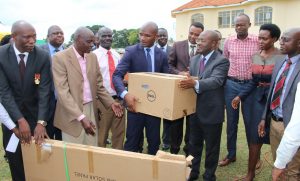Disease Surveillance
Introduction & Background
 Makerere University School of Public Health was awarded a five year CDC/ PEPFAR grant to implement an HIV Disease Surveillance (DS) project as part of the Monitoring and Evaluation Technical Support (METS) Program
Makerere University School of Public Health was awarded a five year CDC/ PEPFAR grant to implement an HIV Disease Surveillance (DS) project as part of the Monitoring and Evaluation Technical Support (METS) Program
This project is intended to support the unique identification and characterization of persons newly diagnosed with HIV or AIDS and tracking them over time. It will provide data on persons at risk to better inform and target programming. Data from individual cases will provide more detailed information on the epidemiology of HIV including district-based estimates of prevalent infection, disease trends (stage of disease at diagnosis, changes in CD4 count, time to viral suppression, proportion of cases virally suppressed, the incidence of opportunistic infections, and mortality), time from diagnosis to entering care, adherence and retention
DS, which will be closely working with Ministry of Health (MoH) and Implementing Partners, will be implemented initially in 2 pilot districts of Hoima and Kabarole. The program will eventually be scaled up to other districts upon successful implementation
Objectives of Case Based Surveillance
- Establish consensus among stakeholders regarding the required elements for Ugandan case-based HIV/AIDS reporting, and develop the technology to implement it
- Pilot and evaluate implementation of case-based HIV/AIDS reporting in a selected district
- Build the capacity of the district and MOH to analyze and use the data obtained from case-based surveillance
- To Roll out implementation of case based HIV/AIDS surveillance to other selected districts
Rationale
HIV Disease Surveillance is a useful approach to monitor trends of prevalent HIV infection, measure linkage and retention, and inform the allocation of resources while providing a platform for tailoring and evaluating HIV programs and providing data for monitoring and evaluation. The 2006 World Health Organization (WHO) guidance for case definitions and surveillance recommends HIV case reporting for adults and children. HIV case reporting adds to other important evidence to sero-behavioral surveys, size estimation studies of risk groups, and sentinel surveillance (usually from ante-natal clinics) to form a more complete picture of the status of the HIV epidemic in a country or region. Disease Surveillance (DS) reporting data can assist with:
- Monitoring trends in incidence and prevalence of HIV infection.
- Characterizing affected populations.
- Identifying the number of persons in need of care and treatment and the allocation of resources to those in need.
- Targeting and evaluating interventions and prevention programs
- Providing context for monitoring and evaluation of data.
Objectives of Using The HIV Case Based Surveillance
- To strengthen HIV surveillance systems to track the entire spectrum of the epidemic including (HIV infection, disease progression, and care and treatment outcomes)
- To complement existing monitoring and evaluation systems.
- To characterize important factors in the epidemic including:
- Monitoring trends in prevalence of HIV infection
- Monitoring new infections in a certain period (HIV Incidence)
- Characterizing affected populations
- Identifying the number of persons in need of care and treatment
- Targeting and evaluating interventions and prevention programs
- Determining number of clients currently on care or treatment
- Determining how long it takes to get individuals from diagnosis into care
- Determining how many initiate ART
- Determining how many are virally suppressed
- Determining the mortality rates among persons living with HIV
- Description of characteristics of persons living with HIV
